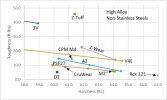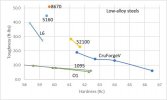- Joined
- Jun 2, 2019
- Messages
- 7
I’ve got two 1meter bars of Vanadis 4e on the way, I’ve not heat treated it before and there’s very little out there to take anything from recipe wise... other than the manufactures HT on the Uddeholm website, which I’m guessing isn’t perfect for knives.
anyway, how closely do you think I’ll need to follow the manufactures recipe or are there any obvious differences that I’ll need make? there anyone willing to share?
thanks
Luke
anyway, how closely do you think I’ll need to follow the manufactures recipe or are there any obvious differences that I’ll need make? there anyone willing to share?
thanks
Luke


